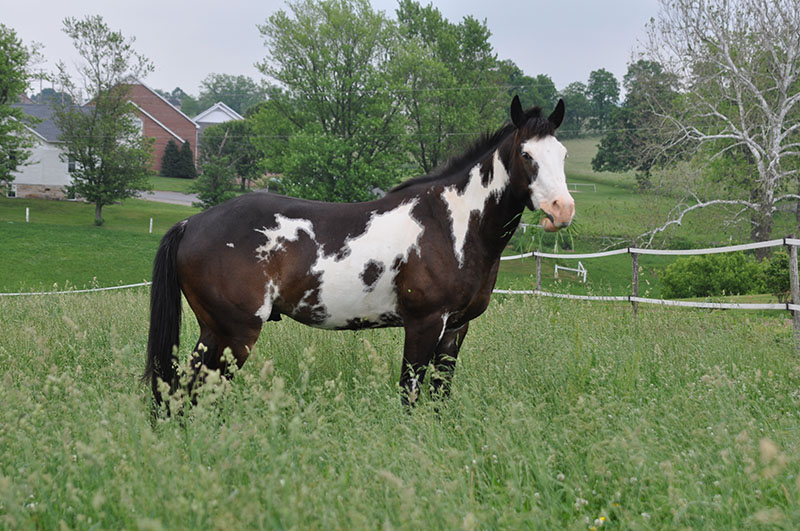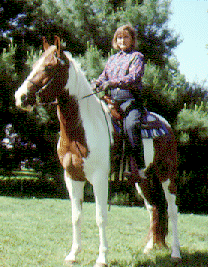Pinto Horses
 The Pinto horse is a color breed in contrast to most other breeds which are defined
by their genetic ancestry. In America, the Pinto is regarded as a proper breed. Pintos
have a dark background coloring and upon this color random patches of white. The Pinto
coloration may occur in any breed or specific conformation. However, the Pinto Horse Association
of America does not accept horses with Appaloosa, Draft, or mule breeding or characteristics.
In the American west, the Pinto has traditionally been regarded as a horse the American
Indian favored as a war horse since its coloring provided a natural camouflage.
The Pinto horse is a color breed in contrast to most other breeds which are defined
by their genetic ancestry. In America, the Pinto is regarded as a proper breed. Pintos
have a dark background coloring and upon this color random patches of white. The Pinto
coloration may occur in any breed or specific conformation. However, the Pinto Horse Association
of America does not accept horses with Appaloosa, Draft, or mule breeding or characteristics.
In the American west, the Pinto has traditionally been regarded as a horse the American
Indian favored as a war horse since its coloring provided a natural camouflage.
Physical Description
The Pinto does not have consistent conformation since it is bred for color. When the darker color is black, the horse is often described as Piebald. When the darker color is anything but black, the horse is described as Skewbald. Pintos may be from a variety of breeds, ranging from Thoroughbred to Miniatures.

There are four acknowledged types of conformation however: the Saddle type, Stock type, Hunter type and Racing type. Type is determined by the conformation and background of each horse/pony. The Stock Type Pinto is of predominantly Quarter and Paint breeding and conformation. The Hunter Type Pinto is of predominantly Thoroughbred breeding and conformation. The Pleasure Type Pinto is of predominantly Arabian or Morgan breeding and conformation. The Saddle Type Pinto is American Saddlebred, Tennessee Walking or Missouri Foxtrotter breeding and conformation.
Pintos are also classified and registered according to their size. Animals maturing over 56" in height at the withers are horses. Ponies are animals 56"and under, but over 34". Any animals 34" and under at maturity is termed a miniature. B Miniature is a further classification for animals over 34" but not exceeding 38" at maturity. Each division, having its own rules and standards, allows for exhibition against "like" conformation and styles.
Saddle Type
Horse: English horse of predominantly Saddle, Hackney or Tennessee Walking Horse breeding
displaying high head carriage and animated, high action of these breeds.
Pony: English-type pony displaying the carriage, animation, and action of the Saddle and
Tennessee Walking Horses and modern style Shetland and Hackney Ponies.
Hunter Type
Horse: English horse of predominantly Thoroughbred breeding.
Pony: Reflects conformation associated with the Thoroughbred horse and Connemara Pony.
Stock Type
Horse: Western horse of predominantly Quarter and Paint Breeding and conformation.
Pony: Western type displaying conformation with Quarter Horse and original Shetland Pony.
Pleasure Type
Horse: Horse of predominantly Arabian Horse and/or Morgan breeding.
Pony: Reflects carriage and conformation associated with the Arabian and Morgan horse and
Welsh pony.
Each type is shown in its own respective class and breeding is encouraged to be kept within a specific type. The association strives to produce each succeeding generation with improved style and talent within one of these types. As with all breeders, Pinto Breeders believe that conformation is an important factor in what a horse can do for the rider.
What is the difference between Pintos and Paints?
Of the questions posed to the PtHA, this is invariably the most frequently asked. Simply put: The Paint Horse (registered by the APHA) is limited to horses of documented and registered Paint, Quarter Horse or Thoroughbred breeding. The difference in eligibility between the two registries has little to do with color or pattern; only bloodlines. While most Paints can be double registered as Stock or Hunter type Pintos, PtHA also allows for the registration of miniature horses, ponies, and horses derived from other breed crosses, such as Arabian, Morgan, Saddlebred and Tennessee Walking Horse, to name but a few.
Origin of the Pinto
Though commonly associated with the Native American for its legendary magical qualities in battle, the Pinto horse was actually introduced to North America by European explorers, chiefly those from Spain, bringing their Barb stock that had been crossed with native European stock years before. It is believed that the Pinto patterns may have arrived in Europe via the Arabian strains, as Pinto markings appear in ancient art throughout the Middle East. However, evidence of the more dominant Tobiano pattern among the wild horses of the Russian Steppes suggests the introduction of Pinto coloring to Europe possibly as early as during the Roman Empire.
After the arrival of these European horses, great wild herds infused with the flashy color patterns we know today began to develop across America, eventually to be domesticated by the Native American. The white man continued to import many of the well-established and stylish European breeds as his foundation stock. Over time, however, with the civilization of the Native American and the white man's migration to the frontier, it often became necessary to cross these fancy, but less suitable breeds of the Eastern seaboard with the wild mustang stock to increase size and attractiveness as well as availability of a horse better suited to the strenuous working conditions of the day. This Western-bred horse became a fixture of America, especially the uniquely marked Pinto whose colorful presence in parades and films always added a little extra glamour.
Notes of Interest
What are the Pinto patterns and how do they differ? There are two recognized Pinto color patterns:
- TOBIANO (Toe-bee-ah'-no) appears to be white with large spots of color, often overlapping on animals with a greater percentage of color than white. Spots of color typically originate from the head, chest, flank, and buttock, often including the tail. Legs are generally white, giving the appearance of a white horse with large or flowing spots of color. Generally, the white crosses the center of the back or topline of the horse. It is considered necessary to have a Tobiano parent to achieve a Tobiano foal.
- OVERO(O-vair'-o) appears to be a colored horse with jagged white markings usually originating on the animal's side or belly, spreading toward the neck, tail, legs, and back. The color appears to frame the white spots. Thus, an Overo often has a dark tail, mane, legs, and backline. Bald or white faces often accompany the Overo pattern. Some Overos show white legs along with splashy white markings, seemingly comprised of round, lacy white spots. White almost never crosses the back or topline. A horse of Pinto coloration descendant from two solid colored parents of another typically solid colored pure breed is called a "crop-out" and is of the Overo pattern.
Pinto Horse Association of America
Choice, versatility and achievement for the breed that offers something for everyone is what the Pinto Horse Association has to offer. The association was formed in 1956 although the bloodlines of many Pintos trace three or four generations before that date. Established primarily as a color registry, today, the association has grown to offer four conformation types. In addition to the four types of horses, PtHA has a separate division for Ponies (measuring over 34" at maturity but not to exceed 56" at the withers), Miniatures (not exceeding 34" at maturity) and Mini "B" (those exceeding 34" up to and including 38").
Two patterns are recognized by the PtHA: Tobiano and Overo. A Breeding Stock Division is offered for solid colored horses or horses with insufficient color to be placed in the color classification and/or horses with documented and registered color in their pedigree or horses with two or more Pinto characteristics. (PtHA does not accept animals crossed with or showing evidence of Appaloosa, Mule or Draft horse breeding).
The Pinto Horse Association has moved its headquarters from Fort Worth, Texas to Bethany, Oklahoma in 2004. With the location change comes many new faces, and opportunities for current and prospective members of PtHA. There will be exciting new changes taking place in the future, we invite you to become a member and be part of the excitement!
The association has a registry of more than 124,000 horses, ponies, and miniatures throughout the U.S., Canada, Europe and Asia. The number of horses and members increases daily. Many local Charter organizations in most areas of the United States and Canada are affiliated with PtHA.
References
Kentucky Horse Park, 4089 Iron Works Pike, Lexington, KY 40511
Pinto Horse Association of America Inc., 7330 NW 23rd Street, Bethany, OK 73008
Phone: (405) 491-0111
Additional information available from the National Pinto Horse Registry, P.O. Box 486, Oxford, NY 13830-0486
Phone: (607) 334-4964
